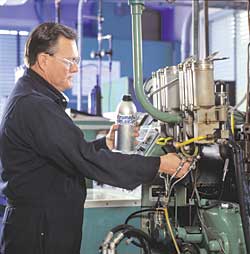Beyond Octane
By Mike Miller
Sunoco Race Fuels
5/8/06
Overheard at the local track:
“High octane fuels burn slower.”
“My motor doesn’t need all that octane so that fuel won’t do me any good.”
“I need the highest octane so I can max out my timing.”
Unfortunately, those statements are not always true. As a matter of fact, those statements only have some merit in the street gas world where 93 octane fuel is king and 87 is used by most. In the world of racing gasolines, where higher octane choices abound, sharp engine builders and racers know they need to look beyond octane to find the right fuel.
Before we ignore octane, it’s important to look at how octane is measured in the first place.
Octane numbers are measured using single cylinder engines that look more like something crafted by Henry Ford than any modern engine. The engines are operated by  trained technicians in labs under controlled conditions. Two tests are used – one for Research Octane Number (RON) and another for Motor Octane Number (MON). The MON test is not as “easy” as the RON test, so the MON is usually lower than the RON.
trained technicians in labs under controlled conditions. Two tests are used – one for Research Octane Number (RON) and another for Motor Octane Number (MON). The MON test is not as “easy” as the RON test, so the MON is usually lower than the RON.
Many times you’ll hear that MON is more important than RON because the MON test is performed under higher temperature and engine speed conditions.
While this may be true, the laboratory test conditions are not indicative of what real race engines – heck, even mild street/strip motors for that matter – see at the track. Also, some engines have shown a better correlation between horsepower and RON. So, a word to the wise: don’t get hung up on octane numbers.
For a great example of why octane is not the only fuel parameter to ponder, let’s look outside of drag racing for a moment and consider the engines used in Formula 1. These engines have compression ratios exceeding 18:1 and spin at RPMs pushing 20,000. Sounds like a candidate for a 116 octane leaded race gas, right? Nope - they use a 96 octane unleaded fuel!
Back to the drag strip, where on any given weekend you can see all sizes and shapes of engines ranging from raspy 2-strokes to booming big blocks, and with all kinds of power
adders thrown in the mix. This is where looking beyond octane becomes real important. What works for your buddy’s Pro Stock car may not work for your other buddy’s turbocharged import.Naturally aspirated race motors with large combustion chambers spinning at high RPMs really like high-octane, fast burning fuels. They need the octane to prevent uncontrolled combustion, and they need a fast-burning fuel so that the flame front can span the large bore of the combustion chamber quickly.
If you’re not sure which fuel burns faster than others, one indicator is specific gravity. “Lighter” fuels – fuels with a lower specific gravity – tend to burn faster because fast burning hydrocarbons are themselves light. Look for a specific gravity close to 0.70 and you’ll likely find a fast burning fuel. Of course, consult with the fuel producer to verify your assumptions. You might be surprised to learn that some of the highest octane fuels may also be some of the fastest burning fuels!